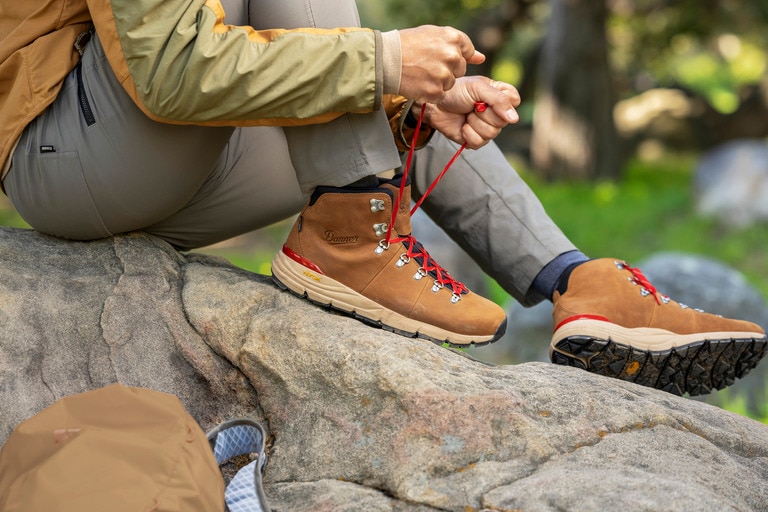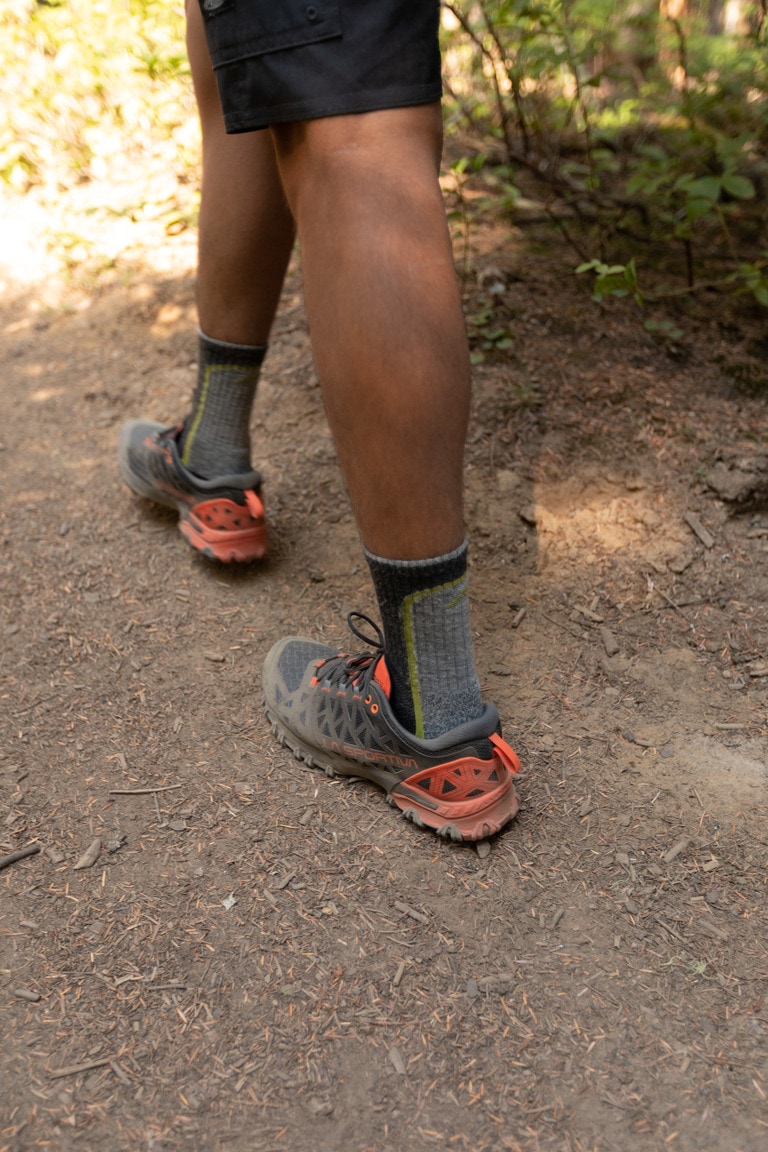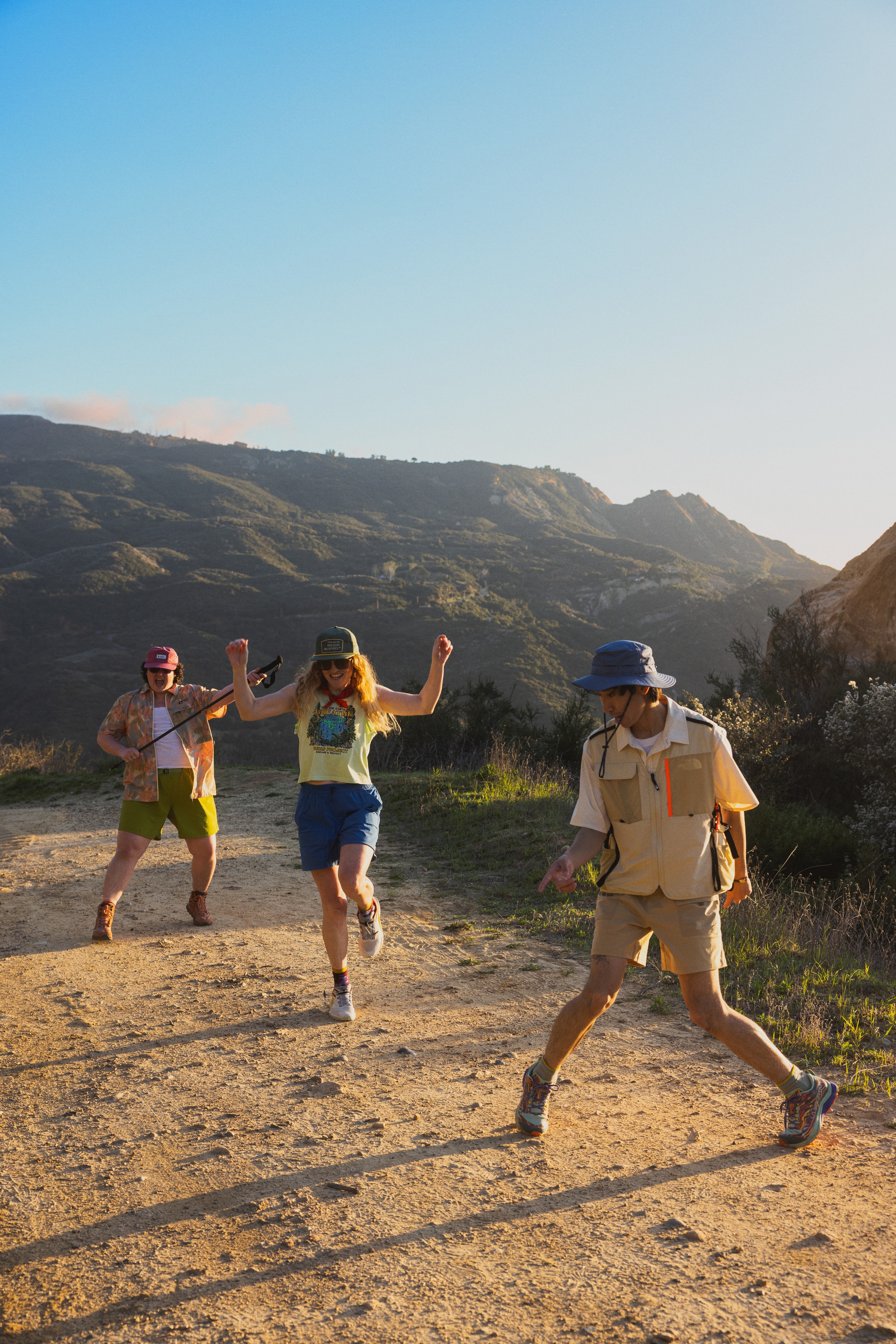Hiking boots had the trail to themselves for decades: Their burly leather uppers, high ankle collars and thick outsoles can be a perfect trail mate for long distances and technical terrain. In the 1980s—with the advent of light, synthetic materials like GORE-TEX—they finally got some less-stiff competition: lower-cut, less bulky hiking shoes, which wear and look more like a sneaker but are designed to go off-road and on-trail.
Today, a wide variety of hiking boots and hiking shoes share the shelves at REI Co-op, and every hiker has footwear preferences (and opinions). In this guide, we’ll look at the differences between hiking boots and hiking shoes, including everything from look and feel to performance. Is one style better than the other, and do you need both in your gear closet?
- Types of hiking footwear We’ll briefly take a look at several footwear options for day hiking, backpacking and mountaineering.
The differences between hiking shoes and hiking boots Hiking boots and shoes typically vary in terms of construction materials, outsoles, ankle support and weight to tackle different environments.
The pros and cons of hiking boots and hiking shoes You’ll want to choose your footwear based on the terrain, duration, intensity and goal of your outings.
Choosing what’s right for you A combination of your hiking habits and personal preferences determines what footwear best suits you.
Types of Hiking Footwear
While there’s always someone on the trail in sneakers or the increasingly popular hiking sandals (and some who hike in bare feet), hiking footwear generally falls in two categories: hiking boots and hiking shoes.
Types of Hiking Boots

Conventional hiking boots are like work boots built for the outdoors: They tend to be taller on the ankle, rigid underfoot, hefty and durable. Many hikers couldn't imagine hitting the trail without the protection and stability of a traditional hiking boot.
There are three primary categories of hiking boots, each with different use case and characteristics:
- Day-hiking boots: These range from mid- to high-cut models and are intended for day hikes or short backpacking trips with light loads. They are often more flexible and require less break-in time than other categories of hiking boots; they also tend to be on the lighter side of the weight spectrum for boots. However, they lack the arch support and durability of stout backpacking boots.
- Backpacking boots: These are designed to support carrying heavier loads on multiday trips deep into the backcountry. Most have a high cut that wraps above the ankles for excellent support. Durable, supportive and heavier-built, with stiffer midsoles than day-hiking boots, they are suitable for on- or off-trail travel.
- Mountaineering boots: Sometimes called alpine hiking boots, these are even taller and stiffer than backpacking boots, designed for summiting snowy peaks. With ¾ or full shanks supporting the entire sole, they are built from sturdy materials like rubber and Kevlar® and are sometimes lined with either single or double insulation for warmth and dryness. Related reading: How to Choose Mountaineering Boots
Types of Hiking Shoes

Imagine your favorite pair of tennis shoes have been hitting the gym and gaining muscle. What you’re picturing are probably hiking shoes. They’re more durable and rigid than your everyday trainers, and they’re ready for more agile adventures outside. They’re typically constructed with layers of synthetic materials, reinforced in key spots while maintaining breathability. Their outsoles tend to have deep lugs for traction, and their midsole stiffness varies. Low-cut models with flexible midsoles are excellent for day hiking and can replace boots entirely for some hikers.
In short, the standard hiking shoe strikes a balance between running shoes and hiking boots. However, a whole world of flexible options technically falls into this category.
- Barefoot or minimal shoes: With minimal to zero padding, barefoot and minimal shoes offer a true feel for the trail and your own biomechanics. These usually require an easing-in period if you’re used to more traditional boots or shoes, as they tend to have little to no heel-to-toe drop (the height difference between heel and forefoot). Related reading: Barefoot/Minimalist Running Basics
- Trail-running shoes: Ultra flexible, lightweight and even more breathable than standard hiking shoes, trail runners can offer great traction, decreased foot rotation and speed. Some ultralight backpackers and fastpackers choose trail-running shoes for long-distance journeys, though, like road-running shoes, they typically last about 500 miles before needing to be replaced. You may choose a different trail-running shoe based on where and how you’re wearing them: There are light trail, rugged trail and off-trail options, with steep variations in midsole padding and rigidity. Related reading: How to Choose Trail-Running Shoes
- Approach shoes: If your hikes involve class 3 scrambles, approach shoes may be just the sticky superstar you’re looking for. A hybrid shoe that aims to combine the grip of a climbing shoe with the comfort of a trail-runner, approach shoes are versatile—good for those shouldering heavy loads and those who fly up rock slabs for breakfast. Though they vary in weight, stiffness, and material, the main trade-off is almost always durability: The softer outsole, while providing increased grip, breaks down faster than your standard hiking boot.
The Differences Between Hiking Boots and Hiking Shoes
At the end of the day, both hiking boots and hiking shoes should help you safely get from point A to point B. Both typically have EVA or polyurethane midsoles and rubber outsoles with lugs, aka those bumps on the bottom of your footwear that provide traction. Beyond that lies a world of difference.
Weight. A light hiking shoe can weigh as little as 1 pound; a sturdy hiking boot can weigh more than 3 pounds. Imagine carrying that weight in your hands over the duration of your hike—you’d only opt for the extra weight if it were worth it for the extra support: Heavier weight is better for long treks where you’re carrying bigger loads, while lighter weight is better for speed and freedom of movement.
Durability. Hiking shoes typically break down before hiking boots. Like a running shoe, a solid hiking shoe might last up to 500 miles, whereas a solid hiking boot can last for twice that or more—especially if it can be resoled.
Breathability. Hiking shoes are typically more breathable than hiking boots, both due to their lighter uppers and thinner soles, and because many hiking boots are often treated with a heavier-duty waterproof membrane. Breathable hiking shoes can prevent sweaty feet, and they can dry quickly when wet. Breathability also means that hiking shoes and trail runners are less suited for cold weather. Hiking boots can resist water, but they will take much longer to dry if they do get wet. They can get quite warm as they are less breathable.
Stiffness. Hiking boots are often made with more durable materials, especially in key spots that typically see more wear—full-grain leather uppers, for example. You’ll also find rigidity in elements like toe guards, shanks and heel brakes. Hiking shoes are often made of lighter upper materials, including synthetics and mesh, and have a more flexible mid- and outsole.
Protection. Hiking shoes—with their increased breathability, flexibility and lower cuts—may offer less protection from the elements and less protection from hazards on rugged, unmaintained trails. Hiking boots tend to more efficiently repel water and provide greater underfoot support against uneven surfaces and rocks.
Height. Many hiking shoes share a silhouette with tennis shoes, wrapping just below your ankle. Hiking boots, meanwhile, come in low-, mid- and high-cut varieties. For some, the ankle protection provided by mid- and high-cut boots means increased stability; for others, ankle protection can feel like restriction.
Winter utility. While hiking shoes can be four-season friends in certain regions (and ice cleats and winter traction devices can fit almost any close-toed shoe), hiking boots provide more warmth and insulation in cold weather.
Hiking Boots and Hiking Shoes: Pros and Cons
Hiking Boots | Hiking Shoes |
Pros
| Pros
|
Cons
| Cons
|
In short, if you're hitting serious trails with heavy loads, you may want a pair of hiking boots. But if you’re carrying a lighter pack, staying close to home, or walking on groomed or paved trails, hiking shoes—lighter, flexible, breathable—might be a better option to help you go the distance.
Choosing Between Hiking Boots and Hiking Shoes
Hiking boots tend to get the most time in the spotlight, and they’re certainly favorites if you’re looking for a thousand-mile companion. But trail runners or hiking shoes may be all you need—they’re easier to break in, weigh less and are often better for balance, as the stiffness and height of a boot can reduce movement and responsiveness. Ultimately, the choice is yours. Here are some things to keep in mind.
Terrain Generally, the more technical the terrain, the beefier your footwear should be for stability, protection and grip. However, if you’re mostly wandering clean, well-maintained or paved trails, a lightweight trail-running or hiking shoe may be your best bet.
Your hiking habits How many miles do you tend to knock off in a day? Do you hike in cold or wet weather? For warmth and long-distance durability—you’re regularly hoofing 10+ miles, say—you might want a sturdier boot. If you’re going for speed and agility, a lighter option will be best.
Pack weight Backpacking boots exist for a reason—their higher cuts and stiffer midsoles offer increased stability and support, which can help when you’re carrying a heavy load. If you’re just going out on casual day hikes with a light pack, you may find there’s no need for a heavy-duty boot.
Shoe weight A hefty hiking boot can weigh 3 pounds—and as backpackers say, “A pound on your feet equals five pounds on your back.” Studies have shown that it can take up to 6.5 times the energy to maintain your pace with extra weight in your shoes. Sometimes, though, you may actually want to carry that extra weight: The added support and durability could be just what your feet need.
Internal thermostat If you generally run hot and worry about developing sweaty feet (read: blisters) during a longer hike, you may want to consider going with a lower, lighter and more breathable pair of hiking shoes. Remember that sweaty feet will eventually also be cold feet, so if you wear insulated hiking boots you'll want to ensure your socks are moisture-wicking rather than moisture-absorbing.
At the end of the day, the hiking shoes versus hiking boots debate isn’t about terrain or distance—it’s about what works for you. Whether you like the heft and protection of a boot or the lightweight flexibility of a trail-running or hiking shoe, one thing is certain: There are plenty of options available to meet your needs.
Related reading

